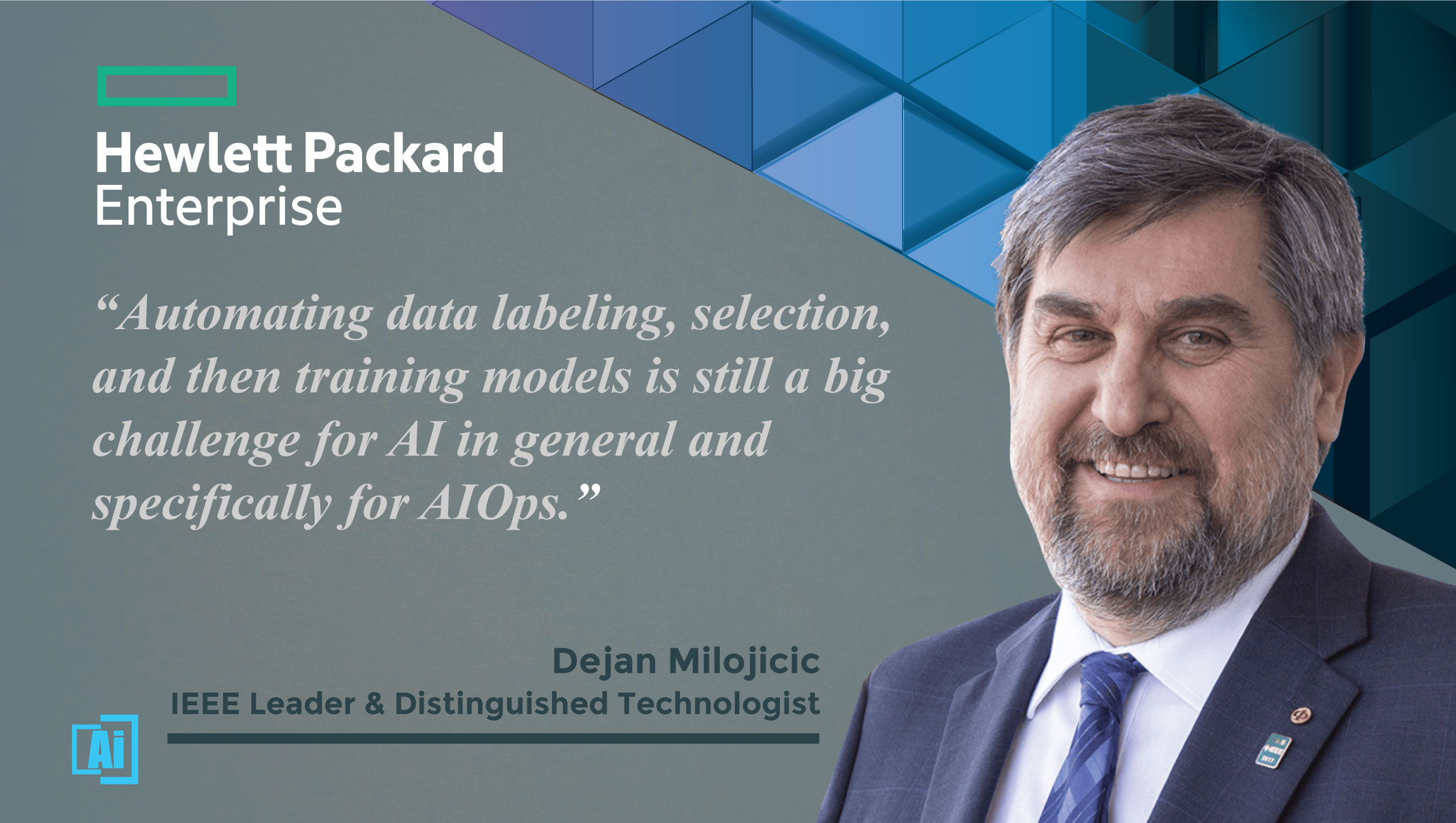AiThority Interview with Dejan Milojicic, Distinguished Technologist at Hewlett Packard Labs

Know Me
Hi Dejan, please tell us about your journey in technology and how you started at IEEE.
My technology journey started in Belgrade in 1983, when after my undergraduate studies in Electronics. I joined Research Institute “Mihajlo Pupin”, where we built new 8086 and thereafter 80386 computers for the transactional systems in Eastern Europe. I spent 8 years there. Thereafter, I got my Ph.D. in University of Kaiserslautern in 1993 and then I joined the OSF Research Institute, Cambridge MA, where I worked for 5 years on parallel and distributed systems.
Last 21.5 years I spent at HP(E) Labs working on a spectrum of system software projects for clients, servers, Clouds, HPC, middleware, firmware, etc. I published almost from the start of my career, and eventually, I also did so at IEEE conference and later magazines and journals including the recent IEEE Computer Society’s Computer magazine dedicated to 2020 technology predictions. Over the years I held IEEE leadership positions, such as Editor in Chief of IEEE Computing Now, President of IEEE Computer Society, and IEEE Director for Division VIII, among many others.
You have garnered a solid reputation for accurately forecasting the future of Computing and Robotics. What do you think about the role of Quantum Computing in an Enterprise IT setup?
I think very highly of Quantum Communication, it has its practical use and credible prototypes exist. I am struggling to see substantial progress with Quantum Computing in the near future. And even if such progress is made, the applications solved with Quantum Computing are limited. It is even more so true for Quantum Computing in Enterprise IT, which will continue to be served by traditional computing for some time to come.
At the same time, there is so much investment around the world poured into this area, that I am confident that something good will come out, even if it is in the areas of Quantum-inspired computing, interconnects, reliability or something else.
Read More: AiThority Interview with Michael Badichi, Co-founder and CTO at Anzu.io
Tell us more about the team you work with? What kind of skills and abilities does one need to be part of your technical team?
The team I work with is the reason I stayed in HP(E) Labs for almost 22 years. My colleagues are deep thinkers yet at the same time practical and able to deliver technologies. They are both technical and business-minded. The spirit of the HP Way still exists, the culture instilled by Bill Hewlett and Dave Packard, but also enriched by the influence of a number of acquisitions we have had over the decade, such as Compaq, SGI, Cray, and many others.
People around me are visionary enough to be able to think outside of the box and also brave and persistent enough to be able to deliver on the visions. Not all visions and technologies we work on are successes, but I would say that our success ratio is much better than that of the startups.
When we hire, we usually interview by a broad team of technologists and technical managers (many times technologists who play a dual role). We look for creativity, technical acumen (hands-on experience), critical thinking, and social skills.
Computing and AI Insights
We hear a lot about AIOps and its role in transforming IT and Cloud Services. What opportunities and challenges do you work with on a daily basis?
AIOps, or sometimes also more narrowly defined as MLOps, have a tremendous opportunity in IT space, but also in OT space (Operational Technologies), in Cyber-Physical systems, and in systems, services, and management in general. The simplest form that predates AIOps, but which AIOps strengthens is in the area of anomaly detection.
While this area was always there, with the broader adoption of Deep Learning and Machine Learning, there are new techniques that can much better detect anomalies in system behavior and help indicate or even predict problems. This is true for management of services and systems (e.g. whether a server’s components are failing, or a turbine is about to have a failure or a component is partially failing, etc.). This is also true for cybersecurity breaches, which are in a way an anomaly from the correct behavior. I foresee substantial expansion in the use of AIOps in the near future in increasingly more areas of systems.
The challenges are in securing and labeling data for the use of AIOps. In many cases, humans are still evolved in this complex process and the results are not ideal. Automating data labeling, selection, and then training models is still a big challenge for AI in general and specifically for AIOps.
Apart from AI and RPAs, we are also seeing the rise of Blockchain in the industry. What are your comments on the role of Blockchain and Crypto platforms? Is AI and Cybersecurity a safe and controllable confluence to deal with? How can the smaller businesses jump into this whole gig economy of AI + Cybersecurity?
It is very important to distinguish fashion from real use. I can see the need for the distributed ledger in many functions that require auditing and close governance of services. This is assuming that the mechanism deployed is appropriate for the use. For example, for lightweight services, it does not make sense to employ a heavyweight ledger. For complex and heavyweight services that may require detailed auditing investing in costly distributed ledger may be very much justified. As the AI and Cloud services continue broad adoption so will distributed ledger.
I have much less confidence in the broad adoption of cryptocurrencies based on current implementations of Blockchain. They may be too early and ahead of their time, but current digital currencies and financial services seem to be working sufficiently well. Again, mining bitcoins seems to be ahead of its time and too costly in terms of execution.
On the other hand, AI and Cybersecurity are in synergy and addressing the real problem. AI can help cybersecurity and cybersecurity can help AI; that is why the term confluence applies to so well to these two technology areas. Because of so much data generated in observing IT events, AI can help distill anomalies and potential threats. At the same time, AI itself is vulnerable to threats, for example, intentional biases, misuse of AI, etc. can all benefit from new cybersecurity approaches. That is why the two technological areas will increasingly more so coexist.
Both small businesses and startups can fit very well into this space because innovation in the infancy of AI can happen anywhere. It does not take huge investments for software development compared to e.g. development of new hardware accelerators which requires hundreds of millions of initial investment.
Read More: AiThority Interview with Ryan Lester, Senior Director of Customer Engagement Technologies at LogMeIn
Governance and Advisory
You work very closely with various international committees and councils. What is the biggest challenge mankind is staring at today? How do you leverage technology to find solutions for these challenges?
The world is fragmented in different areas and countries, with different cultures, regulations, and governance. This has always been the problem but the world has dealt with it. As the connectivity, Cloud services, AI, Automation, etc., continue to evolve, the cost of supporting this heterogeneity is only increasing.
Take for example sustainability. Each country has different regulations, preferences, and technological abilities to track sustainability. A similar situation is with cybersecurity. The attacks can arise from any part of the world and towards any other part of the world. Technology is an enabler both for positive and negative actors. The next example is privacy. It is treated differently in Europe, from the USA, and from Asia Pacific. Technology can help address some of the issues by automating and translating requirements, but at the same time, it is a challenge because a vast number of services need to be addressed to prevent privacy leaks.
Probably the most challenging aspect are those of global impacts, such as climate change and global warming. Technology can help through simulation and better understanding the cause and consequences. At the same time technology is contributing to the problems through large dissipation of energy in data centers, and numerous devices.
What kind of governance policies are we looking at to tackle issues with Data thefts, Frauds and Identity stealing? How can Blockchain governance and Forensics prevent these?
Sophisticated crime is hard to prevent because criminals are leveraging technology, creativity, and innovation at the same rate as authorities who prevent the crime. Technology can help remove entry-level crime through increased device and data protection. Tracking of phone has been widely used and corporations regularly require employee phones to be encrypted.
Security policies and mechanisms are systematically deployed onto individual devices (laptops, tablets, phones) and will increasingly be deployed on IoT devices. Obviously distributed ledgers can record the order of transactions and assist in forensics in cases of fraud, thefts, and criminal activities. In certain cases, this can help proactively in others only reactively.
What is your opinion on “Weaponization of AI and Robotic technologies?” How do you promote your ethical AI ideas in the modern Digital economy?
In the history of mankind, any technology advances were considered for the good of humanity and as a threat. When machines were introduced the first time, the Luddism movement in UK was the result of the fear that machines will take over. The fear is even higher now with the advancement of AI and robotics. The same was true for weapons, such as guns which could be used to defend oneself or to attack others.
The problem was never in the technologies but in their use. This is where regulations can help, by strictly enforcing policies on how AI and robotics can be used, what data can be collected, what constraints need to be met, etc. Many times rules and regulations are really hard to devise and that is where ethical guidance can initially help.
The Crystal Gaze
What digital technology start-ups and labs are you keenly following?
Without stating the names, J, I am following startups in the areas of Deep Learning Accelerators, DevOps, modern Cloud Services (including infrastructure, such as Function as a Service). In terms of labs, I usually track results from other enterprise labs, such as those from Microsoft, IBM, VMware, among others.
What other emerging technologies within your industry are you interested in?
Space satellites in support of the communication on the earth. 3D printing for objects that are hard to impossible to build otherwise. Enabling technologies towards self-driving cars.
Tag the one person in the industry whose answers to these questions you would love to read:
Norm Jouppi, Principal on TPU currently Distinguished Engineer with Google, ex-HP(E) and ex-Digital.
Read More: AiThority Interview with Tom Craig, Chief Technology Officer at Resonate
Thank you, Dejan! That was fun and hope to see you back on AiThority soon.
Dejan is the distinguished technologist at Hewlett Packard Labs, Palo Alto, CA (1998-). He worked at the OSF Research Institute in Cambridge, MA (1994-1998) and at the Mihajlo Pupin Institute in Belgrade, Serbia (1983-1991). He was a technical director of the Open Cirrus Cloud Computing Testbed (2007-2011),
Dejan was president of the IEEE Computer Society (2014) and served on the IEEE Board in 2017-2018. Dejan started IEEE Computing now and became its inaugural Editor-in-Chief, innovating content delivery through mashups.

Innovation drives progress, and Hewlett Packard Labs drives innovation. At Hewlett Packard Labs, we enable fast, fluid transfer of advanced technologies into next-generation products and solutions. We work in collaboration with HPE business groups to deliver the innovation that propels our growth, industry leadership, and competitive advantage.

Comments are closed, but trackbacks and pingbacks are open.